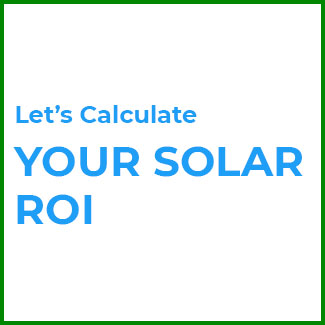Three key drivers determine the return on investment (ROI) of a solar system. These are:
1) The cost of your solar system
2) The amount of electricity your system produces
3) The value of the electricity your system is offsetting
Let’s assume we have an average size solar system in an average solar market in the continental US. A 5 kW system should cost you $20,000 (i.e. $4/W) to build, and it should produce 7,500 kWh (i.e. 1,500 kWh per kW per yr) of electricity per year. And the cost of the (offset) electricity should be about 20 cents / kWh.
In this example, the annual value of your energy production would be 7,500 x $0.20 = $1,500. So you would be getting a 7.5% yield on a $20,000 investment. This would equate to a 13.3 year payback period. This does not look that great. Does it?
Now thankfully, in most places in the US and many other parts of the world, the actual ROI of a solar system is much more attractive than the above example. Read on, to see why that is.
1) First of all, there is still a 30% Investment Tax Credit (in the US) on any solar investment until Dec 31, 2016. This means that for every $1000 invested in a solar system, the US Federal government gives you back $300 in the form of a tax credit. Assuming you are a tax paying person, that would bring the total investment in the above example from $20,000 down to $14,000. And that would change your annual yield from 7.5% to 10.7%. And your payback period from 13.3 years to 9.3 years.
2) Secondly, in many cases, the value of the electricity your system is offsetting is actually higher than 20 cents / kWh. For example, in many large homes in California, and in all homes in Hawaii, the cost of the offset electricity is upwards of 30 cents / kWh. So if we adjust our math such that the cost of offset electricity is 30 cents per kWh instead of 20 cents, then your annual yield will improve from 10.7% to 16.1% and the payback period will improve from 9.3 years to 6.2 years.
3) Thirdly, in many parts of the US and the world, your annual electricity production could be as high as 1,800 kWh / kW / year, or even higher. This adjustment would increase your annual yield even further, from 16.1% to 19.2% and your payback period would improve from 6.2 years to 5.2 years.
4) And finally, with declining costs of solar equipment and other soft costs surrounding a solar installation, the cost of a typical solar installation is decreasing rapidly. The cost of an average solar residential system was $9/W back in 2009, and in 2014, most leading installers installed solar systems at a cost of $3/W or less. Our example above assumed a cost of $/4, counting for a healthy margin for the installer. It is quite possible to get a residential solar system for less than $3.5/W these days (circa mid-2015). In the case of commercial systems, the cost of a system could be as low as $1.5/W.
If the cost of the installed system can be halved to $2/W that would pretty much double the yield and halve the pay back period for each of the above examples.

